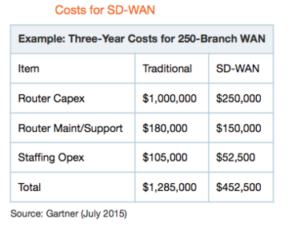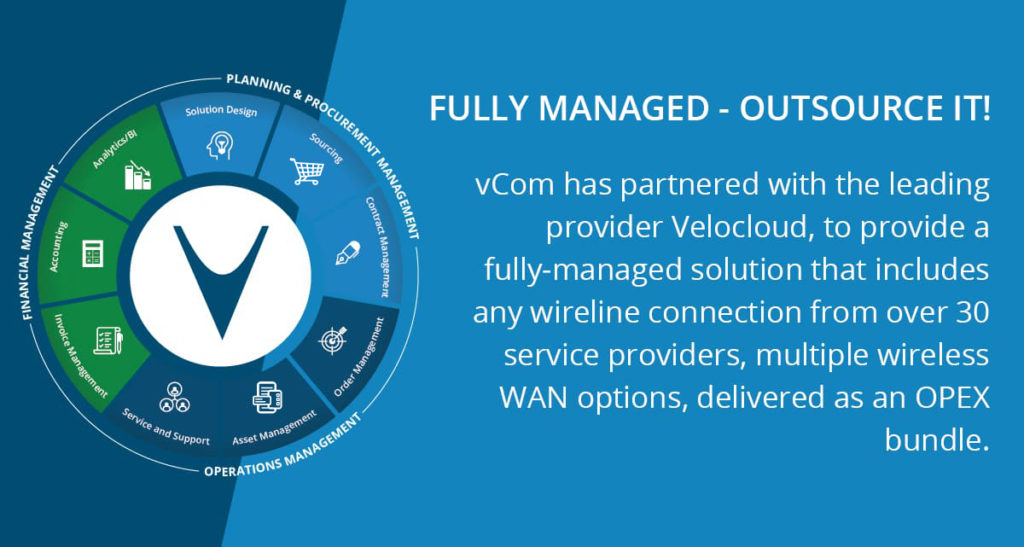[vc_row][vc_column width=”1/1″][vc_column_text]One of the best networking options comes with some unforeseen pitfalls – here’s how to avoid them.
Ah, SD-WAN. You make life so much easier! You’re not proprietary, you’re cost efficient, and you’re extremely scalable – allowing my company to bounce between the providers that work best for us. Being able to choose providers means more flexibility (and who doesn’t love options!) – but wait a minute! Flexibility means decisions, and these decisions require expertise, skill, and accountability. This increased oversight is the result of having a variety of service options. In other words, an SD-WAN solution requires management to moderate the fragmented billing, execution, and decision-making that comes with it.
Suddenly, this thing that offers so much upside is creating a lot more work on the back end. In short, it creates two new problems – one of technical management and one of spend management. Now we’re big believers in SD-WAN. So, first let’s discuss the amazing benefits that come with it, then do a flyover of the new issues that arise with adopting it. Lastly, and most importantly, we’ll address how to solve for these hiccups so you can get the most out of SD-WAN.
Why SD-WAN is the Right Choice

SD-WAN isn’t just a better way to network – it’s truly a best of breed technology. It earns this classification because it does far more than just advance the tech; it also creates significant impact on your business in both revenue and process. Companies that switch from traditional networking – like MPLS – to SD-WAN have showcased results of up to 20 times more bandwidth, significant decrease in downtime, improved Internet redundancy, better quality of service, and a networking solution that provides a ton of modality. That’s an impressive list of technical upgrades, but if money is more your thing, then you’ll be happy to know that companies have also reported saving thousands of dollars per month when switching to SD-WAN. Both CTO’s and CFO’s will rejoice over these results.

All of these benefits that come with SD-WAN are made possible because the technology provides your network with something that was previously unavailable: choice.
Choice is great, but choice means increased decision-making, which quickly turns into great complexity. Overnight you go from a ship traveling in a single direction to now having the freedom to sail wherever your heart desires. It’s freeing – but also terrifying. Multiple vendors, contracts, terms, and pricing are just a few of the many new experiences you’ll encounter with SD-WAN – and it’s easy to quickly become fatigued and overwhelmed, both in deciding which options best suit your business and the expanding influx of fragmented billing and tracking. This increased complexity requires experts and the right tool set to help you navigate the endless SD-WAN seas – to point you in the right direction towards improved performance and cost savings rather than the wrong path that leads to time wasted and money lost.
Ultimately, companies that go with SD-WAN need a spend management firm or aggregator to truly make SD-WAN beneficial, and to avoid the following problems that will occur without proper guidance.
Problem #1: Replacing Maintenance with Management

This is the untold story of SD-WAN: the clunky hardware, installation, and costly upkeep of previous services like MPLS get replaced with the necessary full-time staff needed to efficiently operate your new network. To put it simply, adopting SD-WAN without a managerial plan to oversee it is like switching from hardline Internet to Wi-Fi, but no one knows the password to get on it. Pretty useless, right? This is perhaps the biggest hidden cost in our ever growing SaaS-driven business landscape – that the more we adopt cloud-based solutions, the need for maintenance turns into a need for management.
So, the solution seems simple on paper: hire more employees. However, hiring is never that simple. To be fair, the cost comparison between acquiring and operating old networking tech versus the newly required staff to manage SD-WAN still nets positive, but more people on payroll can affect a business in ways beyond budget, such as:
- More time spent on people management.
- New company needs across IT, Finance, and HR.
- Possible tax implications for public companies.
Not every business is prepared to take on more people. Unfortunately, companies shift to an SD-WAN infrastructure (which they absolutely should for many reasons) but disregard the time and people investment required to efficiently leverage it. They don’t make the necessary hires to manage it, and their decision to invest in SD-WAN because of its cost and performance benefits quickly becomes a loss. SD-WAN’s best capabilities don’t get utilized, and it turns into money going down the drain – both in cost for the service and in the time lost trying to halfway manage it. The management involved with an SD-WAN environment is not part-time; it’s exhaustive – requiring a blend of constant surveillance, deep expertise, and creative troubleshooting, including, but not limited to, the following operational tasks:
- Customizing bandwidth and rolling out network-wide updates.
- Monitoring usage and scaling deployment when traffic increases.
- Overseeing encryption tunnels, which is especially important in the legal and medical industries.
When it comes to your network – the lifeline of your business’ communications and productivity – these are duties not to be taken lightly.
Problem #2: More Choices, More Bills

The second problem with SD-WAN is one of dollars and sense (yes, sense, not cents). Because SD-WAN is ubiquitous, we are free to make decisions that best suit our network. This means we need to have a sense of the financial impact involved with those choices. If we don’t track and measure our decisions, the nature of SD-WAN and the self-government that comes with it can be costly. Gone are the MPLS days of knowing your bandwidth limit and actively avoiding overcharges (yay!), but now our limitless carrier and provider options means every decision has financial ramifications. Not managing those decisions can quickly lead to overspending, shadow IT, unaccounted licenses, and headaches for your billing department as they shuffle through dozens of bills from various carriers and providers.
Between technical support and spend management, it’s clear that adopting SD-WAN requires two distinct additions to the way we do business.
A Technical and Spend Solution
So what is the best solution to manage your SD-WAN investment? The answer is both technical and spend-related.
On the technical side, hiring a capable network manager seems like the immediate answer. Many businesses might opt to use existing resources, and see how their current IT team could take on these new responsibilities. Whether or not a company staffs up to support its SD-WAN adoption, the ability to properly manage it still remains. As the old adage goes, you need the right tools for the job. In the case of SD-WAN, the tool needed is an effective management platform.

When it comes to spending, the flexible, ubiquitous nature of SD-WAN means every decision made using the technology will affect budget – so the best tool is one that manages both services and spend. Many SD-WAN platforms out there only provide controllers that support technical management, which solves for best leveraging your network’s abilities but can easily snowball into a spending nightmare. Without proper tracking, the ability to switch between a multitude of carriers is a quick way to rack up a hefty monthly bill. vCom Solutions’ inclusion of SD-WAN into our IT spend management lifecycle platform, vManager, helps track not only the technical performance of your network, but the usage and spending practices associated with it, as well.
Tackling the technical without considering the spending only solves for half of the equation – but if you can get yourself a platform that does both, you’ll be enjoying all of the freedom, scalability, and savings that come with adopting SD-WAN, without the new headaches.
Finish What You Started
The whole reason why new technology ultimately gets adopted is because it makes certain tasks easier. Yes, SD-WAN does that in spades. By detaching networking from hardware, the cost to connect remote offices and branches has plummeted, but this new tech comes with the technical and spend management caveats previously outlined. For a solution that promises to be cost-friendly, streamline your workflow, and make doing business easier, it seems ironic to allow it to disrupt your employees’ work load, increase your headcount budget, or not use it to its fullest potential due to negligence.
So I beg of you – do something. Finish strong. You made a great decision in transitioning your network to SD-WAN, but that is the first step in truly getting the most out what can be a huge benefit in the way you do business.[/vc_column_text][/vc_column][/vc_row]


